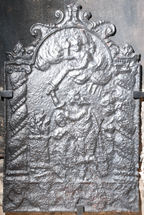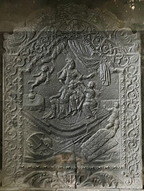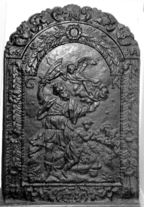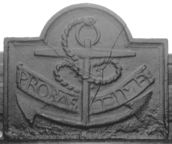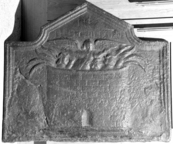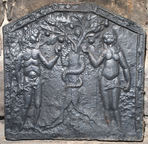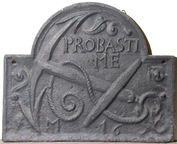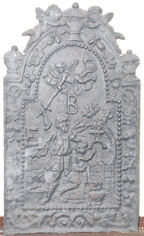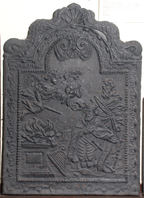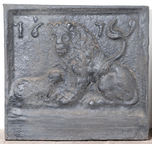-
1001
Description: Arched rectangular panel with a Salomonic column on each side enclosing a scene of Abraham about to sacrifice Isaac but being restrained by an angel; below, bottom panel of indeterminate decoration (due to corrosion); above each column a burning torch, with symmetrical floriate scrolls over the arch.
Notes: Given the biblical subject, this is probably of German manufacture although the Salomonic columns are more often encountered on English pastiches of the 'Dutch' style.
- Decoration tags:
- 'Dutch' (shape)
- fillet (edging)
- whole carved pattern
- pictorial
- biblical
- architectural
- humans
- objects
Manufactured: in the late-17th to early-18th century possibly in the Siegerland area of Germany.
Current location: Ashmolean Museum Broadway, 65 High Street, Broadway, Worcestershire, England.
(part of the Ashmolean Museum museum group)
- Attached to series:
- Old Testament & Apocrypha firebacks
- 'Dutch' Miscellaneous Firebacks
-
874
Description: Arched rectangular central panel with ovolo linking curves and eyelet astragal edging; pictorial scene of Delilah, seated above a pavement, supervising the cutting of Samson's hair by a barber, a putto to the left and a small figure lower right; drapery above; arched rectangular border with ovolo linking curves and fillet edging; symmetrical pattern of plant tendrils with leaves and seed pods; at bottom, monogram 'EB' in a cartouche between symmetrical leaves and ears of wheat; on top, two mirrored sea serpents.
Notes: One of a small series of firebacks identified by the EB monogram; the pictorial scene is of Delilah and the sleeping Samson with a Philistine cutting his hair; the scene may be based on an engraving by the Dutch artist Philip Galle (1537-1612) after a painting by Maerten van Heemskerck.
Copies of this fireback are known.
Inscription: EB
Manufactured: in the late-17th to early-18th century in England.
Current location: Chastleton House, Chastleton, Oxfordshire, England.
Museum number: 1430205 (part of the National Trust museum group)
- Attached to series:
- EB series
- Old Testament & Apocrypha firebacks
- British 'Dutch' style firebacks
-
139
Description: Arched rectangular shaped central panel with bead-and-pellet edging; figure of Abraham, a scimitar in his raised right hand, which is being restrained by an angel emerging from a cloud; Isaac is kneeling to Abraham's left and a ram is caught in a bush to the left of the plate; the initials are in the top corners; arched rectangular shaped border with fillet edging, and swags of leaves suspended from flowers; on top, symmetrical foliate swirls.
Notes: The design is an adaptation of an engraving by Adriaen Collaert (1555-1623) of a painting by Maarten de Vos (1532-1603), Plate 5 of The Story of Abraham. In the 'Thesaurus sacrarum historiarum veteris testamenti', published in Antwerp by Gerard de Jode (1509-1591) in 1579, 1585 and, subsequently, by Visscher in 1589. One of a small group of firebacks, all of similar shape, some with biblical designs, others mythological, all dated around 1700 and bearing the letters GK. Formerly part of the Ade Collection (from Grove Hill, Hellingly, Sussex).
Copies of this fireback are known.
Inscription: G K / 1700
- Decoration tags:
- 'Dutch' (shape)
- fillet (edging)
- whole carved pattern
- individual letters
- biblical
- text
- humans
Manufactured: in 1700 in the Siegerland area of Germany.
Current location: Hastings Museum and Art Gallery, John's Place, Bohemia Road, Hastings, East Sussex, England.
Museum number: HASMG: 1952.51.37 (part of the Hastings Museum museum group)
Citation: Lloyd, N., 1925, 'Domestic Ironwork I', Architectural Review, 58, pp. 58-67.
- Attached to series:
- 'Dutch' GK series
- Old Testament & Apocrypha firebacks
- Abraham & Isaac firebacks
-
142
Description: Arched rectangular shaped; cavetto moulded edging (top and sides); a cabled anchor palewise, behind it the inscription on a scroll parallel with the anchor flukes.
Notes: The inscription is a quotation from Psalms 139: 1: 'Domine, probasti me et cognovisti me' - Lord, Thou hast searched me and known me. Another version of the same design may come from the same source. Formerly part of the Ade Collection (from Grove Hill, Hellingly, Sussex).
Copies of this fireback are known.
Inscription: PROBASTI ME [Thou hast searched me]
- Decoration tags:
- rectangular with round arch (shape)
- cavetto (edging)
- whole carved pattern
- heraldic
- text
- objects
Manufactured: in the mid- to late-17th century possibly at Brede Furnace in the Weald area of England.
Current location: Hastings Museum and Art Gallery, John's Place, Bohemia Road, Hastings, East Sussex, England.
Museum number: HASMG: 1952.51.38 (part of the Hastings Museum museum group)
- Attached to series:
- Small cavetto series
- Old Testament & Apocrypha firebacks
-
159
Description: Rectangular with ‘pediment’ arch linked by cavetto curves; fillet and cavetto edging; pictorial, a cylindrical furnace with inscribed stone courses, flames issuing from the top, with the heads of three people, a hand raised from two of them, and an angel with wings and arms outstretched; the furnace has a small arched opening bottom centre; above the angel, the inscription was inscribed on the pattern.
Notes: The scene represents Shadrach, Meshach, and Abednego being delivered from the burning fiery furnace by the angel of God (Daniel 3), the phrase, The Three Children, being a reference to the eponymous apocryphal verses from the Book of Daniel. Formerly at Brightling Hall, Robertsbridge, Sussex.
Inscription: THE THREE CHILDREN
- Decoration tags:
- rectangular with pediment (shape)
- cavetto (edging)
- whole carved pattern
- pictorial
- biblical
- architectural
- text
- humans
- objects
Manufactured: in the early- to mid-17th century possibly in the Weald area of England.
Current location: Hastings Museum and Art Gallery, John's Place, Bohemia Road, Hastings, East Sussex, England.
Museum number: HASMG: 1913.58 (part of the Hastings Museum museum group)
Citation: Baines, J. M., 1958, Wealden Firebacks (Hastings Museum).
Citation: Butterfield, W. R., 1916, 'Old Wealden Firebacks', The Connoisseur, 46, pp. 197-209.
Citation: Butterfield, W. R., 23 Feb 1935, 'A Scriptural Fireback', Hastings and St Leonards Observer.
- Attached to series:
- Old Testament & Apocrypha firebacks
-
843
Description: Canted rectangular shape; double fillet edging (top and sides) with alternating roses and diamonds between the fillets; pictorial scene of Adam and Eve, both naked, taking fruit from the Tree of Knowledge, between them, around which is entwined the serpent.
Notes: Boldly sculpted, stylised figures; the serpent is shown with a human face.
Copies of this fireback are known.
- Decoration tags:
- rectangular with canted top corners (shape)
- double fillet (edging)
- whole carved pattern
- planklines
- pictorial
- biblical
- animals
- humans
- plants
Manufactured: in the late-16th to early-17th century possibly in the Lorraine area of France.
Current location: Old Manor House, Ilkley, West Yorkshire, England.
(part of the Bradford Museums and Art Galleries museum group)
- Attached to series:
- Old Testament & Apocrypha firebacks
- Adam & Eve firebacks
-
408
Description: Arched rectangular shape; cavetto moulded edge all round; holes pierced in top corners; a fouled anchor with one fluke resting on the base, a scroll below each top corner, foliage above the text, which is above the anchor; the initials either side of the lower fluke.
Notes: The inscription is a quotation from Psalms 139, v. 1: ‘Domine, probasti me et cognovisti me’ (Lord, thou hast searched me and known me).
Copies of this fireback are known.
Inscription: PROBASTI / ME / I M 16 5[0?]
- Decoration tags:
- rectangular with round arch (shape)
- cavetto (edging)
- whole carved pattern
- individual numbers
- planklines
- pictorial
- biblical
- text
- objects
Manufactured: in the mid-17th century possibly at Brede Furnace in the Weald area of England.
Current location: Anne of Cleves House, Southover High Street, Lewes, East Sussex, England.
Museum number: LH000.908 (part of the Sussex Archaeological Society museum group)
Citation: Dawson, C., 1903, 'Sussex Iron Work and Pottery', Sussex Archaeological Collections, 46, pp. 1-54.
-
413
Description: Arched rectangular central panel with bead edging; standing figure of Abraham about to sacrifice a kneeling Isaac, Abraham's raised right hand holding a sword is retrained by an angel; behind Abraham is a ram; initials are placed in a triangle above behind and in front of the group; arched rectangular border with fillet edging and descending floral and fruit bunches on a ribbon, hanging from rings, foliate swirls at base; vases on rectangle shoulders and at top, between two putti
Notes: The initials appear to have been added subsequently.
Inscription: B / E A
- Decoration tags:
- 'Dutch' (shape)
- fillet (edging)
- whole carved pattern
- individual letters
- pictorial
- biblical
- text
- humans
Manufactured: in the mid- to late-17th century possibly in the Siegerland area of Germany.
Current location: Anne of Cleves House, Southover High Street, Lewes, East Sussex, England.
Museum number: LH000.946 (part of the Sussex Archaeological Society museum group)
-
424
Description: Arched rectangular central panel with bead edging terminating at the top in two loops, gather drapery and a scallop shell; two figures to the right, both bearded, the one kneeling wears cavalry armour, a cloak and a crown, the other stands behind; to the left is a sacrificial pyre on which an ox carcass burns, and above an angel carrying a sword in his right hand and a skull in his left; around this is an arched rectangular border with fillet edging and a repeated leaf pattern; on top is a scallop shell between two dolphins.
Notes: The scene illustrates the visitation of the pestilence on Israel described in 2 Samuel 24, and the sacrifice of an oxen by King David; the skull borne by the angel represents the death of those struck down by the plague. A slightly different version has the face of David looking down (no. 527). Formerly part of the J. H. Every collection.
Copies of this fireback are known.
Manufactured: in the mid- to late-17th century in the Siegerland area of Germany.
Current location: Anne of Cleves House, Southover High Street, Lewes, East Sussex, England.
Museum number: 1944.24.070 (part of the Sussex Archaeological Society museum group)
Citation: Hughes, G. B., 1960, Collecting Antiques (London, Country Life), pp. 85-93.
-
481
Description: Rectangular; cavetto edging all round; seated lion on right, its tail rising above its back and its head turned to face the viewer; a seated sheep on the left; at the bottom, a plain rectangular extension panel; date split across top.
Notes: Intended to represent the saying, ‘The lion shall lie down with the lamb’, a popular misquotation of Isaiah 11: 6.
- Decoration tags:
- rectangular (shape)
- cavetto (edging)
- whole carved pattern
- individual numbers
- extension panels
- pictorial
- biblical
- text
- animals
Manufactured: in 1679 in the Weald area of England.
Current location: in private hands, Maresfield, East Sussex, England.
- Attached to series:
- Small cavetto series
- Old Testament & Apocrypha firebacks
